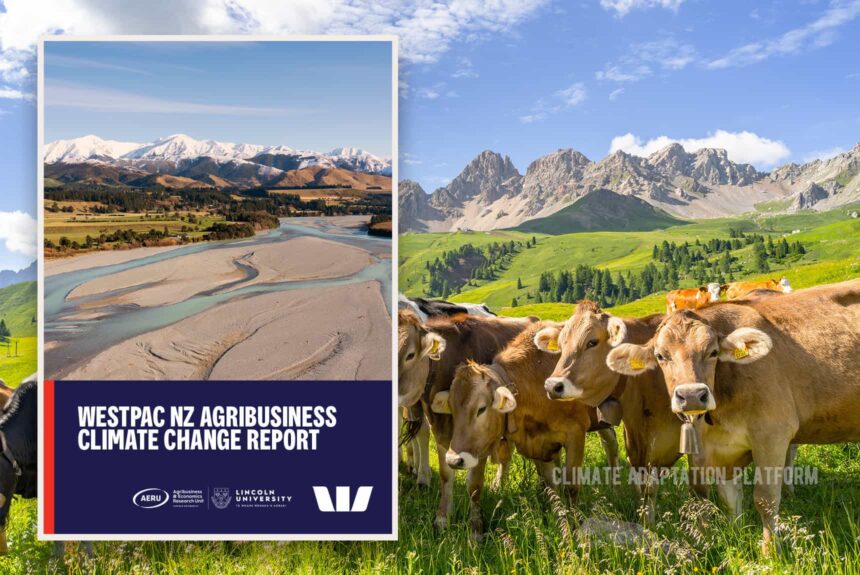Climate change is an increasing concern for New Zealand farmers. The country’s agriculture sector emissions account for almost half its total emissions.
The government will require the sector to reduce emissions to meet New Zealand’s net zero targets by 2050. It also targets to reduce biogenic methane emissions by 10% below 2017 levels by 2030 and up to 47% below 2017 by 2050.
Westpac’s report, which the Agribusiness and Economics Research Unit (AERU) at Lincoln University in New Zealand conducted, investigates the risks and opportunities that climate change brings to New Zealand farmers. It focuses on the dairy, sheep, beef, and horticulture industries and how the sectors can efficiently address the effects of climate change on farming.
The report finds that farmers will need to adopt agile management practices to meet the challenges posed by climate change which consists of cutting emissions and adapting to its effects.
According to the report:
- NZ will experience continuous warming towards the end of the century, making heatwaves and droughts more common in future.
- There will be a decrease in the number of cold temperatures and frost. Warmer temperatures will also bring more intense and heavy rain. The western and southern parts of the country will experience more rainfall, while the North Island and eastern parts will become drier.
- Warmer temperatures will increase pasture growth which can benefit the dairy sector. However, heat stress and droughts will also challenge farming systems in the next thirty years.
Westpac NZ Head of Agribusiness Tim Henshaw says the report and a series of factsheets were designed to provide Westpac customers and other farmers and growers with impartial information about how climate change may affect their location and type of production and how they can respond (Gray, 2022).
Henshaw said that the report finds that a range of management options are already available to New Zealand farmers to help them strengthen their systems’ physical resilience and meet the country’s 2030 climate targets, with only a few requiring a capital investment.
“However, applying these options more widely will require an uptake of best practice farm management. This may require a significant uplift in skills and training to ensure that more farmers have sufficient expertise to reduce emissions and adapt to climate change,” Henshaw says (Gray, 2022).
The report presents case studies to make the information relevant to farmers and growers. For example, it looks at the effect of drought on a dairy farmer in Canterbury and how the warming winters impact the Bay of Plenty’s kiwifruit growers.
Talking about what farmers can do, Henshaw says, “There is no single off-the-shelf solution. I’d encourage primary producers to think about how the climate is changing in their part of the country and what effect that will have on production. They also need to consider what expertise they have available to adapt their operations and plan to fill that gap if it exists” (Gray, 2022).
The report discusses how droughts can affect farm profit for farmers—a moderate drought to reduce dairy farm profit by 30%. But two successive years of drought can eat up 46% of the profit in the North Island and 65% in the South Island.
Farmers and growers already have a range of options available to reduce risk and remain profitable despite the climate change experienced in the present and the future.
Adaptation strategies may not eliminate all the risks, but they can reduce the impacts on farm systems. Due to the uncertainties of future climate change impacts, farmers should adopt flexible climate adaptation strategies as it is more resilient.
A range of GHG reduction options is also available such as feed pasture, stock and effluent management for pastoral producers, crop and soil management and technology investment for all sectors to help them achieve New Zealand’s 2030 methane reduction targets.
For example, conversion or diversification from pastoral to horticultural production also leads to a steep reduction in GHG emissions and improves farm profits. Trees planted on marginal land can reduce emissions while providing other benefits like enhancing soil and water quality, increasing biodiversity, and helping control floods.
The report says that achieving the country’s climate target will involve improving technologies, implementing best farming practices, and changing land use.
While climate change presents challenges and risks for New Zealand’s agricultural sectors, some opportunities arise, especially for farmers and growers who are agile enough to act on the changing climate and regulatory and consumer markets.
You can read further by clicking on the links in the “Source” section below.
Source:
Lincoln University releases information about the way climate change may affect farming locations and type of production, and how farmers can respond, in a Westpac-supported report. (2022, November 29). Retrieved from https://www.interest.co.nz/rural-news/118660/lincoln-university-releases-information-about-way-climate-change-may-affect
Gray, J. (2022, November 29). Agility in farm management needed to cut emissions and adapt, says Westpac report. NZ Herald. Retrieved from https://www.nzherald.co.nz/business/agility-in-farm-management-needed-to-cut-emissions-and-adapt-westpac/
Westpac NZ Agribusiness Climate Change Report. (n.d.) Retrieved from https://www.interest.co.nz/sites/default/files/2022-11/Westpac%20NZ%20Agribusiness%20Climate%20Change%20Report.pdf



Leave a Reply